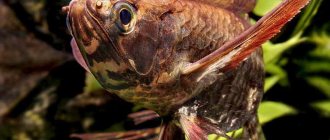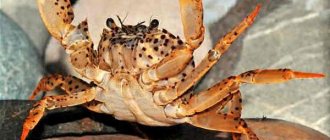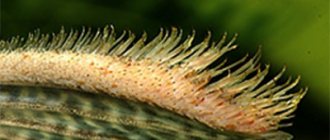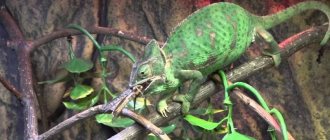The royal panak is a catfish with a very extravagant coloring, one of the brightest representatives of the loricariid family. This bottom dweller is very intolerant of other catfish encroaching on its territory. The only way out when placing a panaka in a common aquarium with other catfish is to equip the pond with various shelters (the more, the better). The shelter in which he will settle will be carefully guarded by him. In general, panakas like to climb into all sorts of holes and get stuck there. When they begin to move back, their spines spread out (like a harpoon) and further advancement becomes impossible without human intervention. If you do not notice a stuck catfish in time, it may die. That is why all shelters and caves must be of such a size that the panak catfish can turn around in them.
[contents]
Another indispensable condition, as for all loricariids, is the presence of driftwood in the aquarium, which serves as a food additive. Without it, catfish have intestinal problems. It is better if the driftwood is made of soft wood, for example from an apple tree. Read about its processing here.
Habitat
Catfish are native to South America.
It is found in the Orinoco River basin and some tributaries of the Amazon in Venezuela, Colombia and Brazil. Inhabits both main river channels and small channels. Brief information:
- Aquarium volume - from 200 liters.
- Temperature - 24–28°C
- pH value – 6.0–7.5
- Water hardness - soft or medium hard (5–15 dGH)
- Substrate type - any dark
- Lighting – dim or moderate
- Brackish water - no
- Water movement - weak to moderate
- The size of the fish is up to 43 cm.
- Food - any sinking food with herbal supplements
- Temperament - uncooperative with benthic species
- Keeping alone or in large groups
"Blue-Eyed Panakas"
Panaque cochliodon
- Panaque cf. cochliodon "upper magdalena" (Colombian Blue Eyed Pleco)
- Panaque cochliodon (Blue Eyed Royal Pleco)
- Panaque suttonorum Schultz, 1944 (Venezuelan Blue Eye Panaque)
- Panaque cochliodon, or rather its two morphs, are indigenous to Colombia, namely they live in the upper reaches of the Río Magdalena (Rio Magdalena) river, or more precisely in the Rio Cauca (Cauca River).
But Panaque cochliodon (Blue Eyed Royal Pleco) has spread to the Rio Catatumbo River. Although it seems to me that most likely it was the other way around (from Catatumbo to Cauca)
What are the differences? And the differences, unfortunately, are not so obvious.
Panaque cf. cochliodon "upper magdalena" (Colombian Blue Eyed Pleco) will be number 1 (will be first) and Panaque cochliodon (Blue Eyed Royal Pleco) will be number two.
The common features are, as the name suggests, blue eyes. Also, these catfish have similar sizes of about 30 centimeters.
The massive pectoral fins have spines that are derivatives of the skin. Their function is to protect against predators and are needed so that the catfish can understand where it can get through and where it cannot.
As for determining gender, they have no information. But I would risk very timidly suggesting that the main identifier can be the outer rays of the caudal fin, which form “braids”, that is, they grow much stronger than the rest.
But who has them more expanded is unclear; I would venture to guess that in males (by analogy with cacti).
Let's get back to business. The first difference between the first type and the second that catches the eye is the shape of the body.
The first is significantly more elongated, which is associated with living in a faster current.
The second difference is the dorsal fin spines. Both have 8 of them, which is a sign of belonging to the genus Panaque, as mentioned above. In both, the spines branch somewhat closer to the end of the fin.
The middle rays are the most branched. So, in the first, rays from 3 to 6 inclusive begin to bifurcate approximately in the middle, in the second, closer to the upper third of the fin. Also, do not forget about the second dorsal fin, represented by a separate spine.
In the first, it is located significantly closer to the dorsal (dorsal fin) and with age practically fuses with it, forming a single whole. The second one has it closer to the tail.
As you can see, the differences between these catfish are not so obvious, this article will be finalized, and if I notice something else, I will definitely make adjustments.
Panaque suttonorum Schultz
Oh, how can I forget about Panaque suttonorum Schultz, 1944 (Venezuelan Blue Eye Panaque)? No way. Let's get started.
This hardworking animal lives in the fast and muddy waters of the Rio Negro and its tributary Rio Yasa, as well as in the Maracaibo basin. In general, the master of the waters of Venezuela.
The only noticeable, in my opinion, tangible difference from the previously described species is a more massive caudal fin with a large number of branched rays, the outermost of which form “braids”.
You can also add the ebb of the scales. If previous comrades had a bluish tint to their scales, which changed with age, then this one’s scales move from black to brown and beige tones.
Otherwise, the species is painfully similar to the previous ones, with the exception of some small nuances in the geometry of the body that are not so obvious without having individuals of all three species in front of you.
With “Blue Eyes” it is clear that nothing is clear. Go ahead -
Description
Adults reach a length of up to 43 cm. In the first year and a half they grow quickly, reaching 20 or more centimeters. Then growth slows down and they reach their maximum size only by 7–10 years.
It is a closely related species to Plecostomus, having a similar appearance to them. The entire body is covered with bone plates, the integument is hard with numerous spines. The first rays of the fins are sharp spines. The body pattern consists of alternating brown and light cream or white stripes. The eyes are red.
The mouth is a suction cup, with the help of which the fish scrapes off the nutrient layer from the surface of driftwood, fruits, leaves and plant trunks.
Royal Panac (Panaque nigrolineatus)
Panaque nigrolineatus or, as it is popularly called, the royal panak, belongs to the species of chain-mailed or loricarian catfish. It is a rather large-sized fish with an elegant color and capricious habits.
Origin
This species of catfish is native to the waters of South America. The river panac lives in the currents of the Orinoco and some tributaries of the Amazon, cutting through the territories of Venezuela, Colombia and Brazil. It is found both in the main streams and in small branch branches.
Conditions of detention
To settle and comfortably live a panak, an aquarium with a volume of at least 200 liters is required. The water temperature should be between 24 and 28 degrees. It is better to keep the water in a soft or medium-hard state. The filling substrate can be of any dark type. Lighting will need to be moderate or dark. The water should not be salty, and the movement in it should remain moderate.
The king panac should be fed with sinking food, preferably with herbal additives. This subspecies of catfish is not compatible with bottom-dwelling species. It is preferable to be kept in small groups or alone.
External characteristics
The maximum permissible size for fish of this species is 43 cm. The main growth rate occurs in the first half of life after birth. In a year and a half, an individual can reach 20 cm. Subsequently, it does not grow so quickly. Growth stops at the final level only at 9-10 years.
The body of the fish is covered with hard bone plates with protruding spines. There are sharp spines on the upper, initial fins. The color of this fish is distinguished by brown and light cream or white stripes.
The fish's eyes are red and its mouth resembles a suction cup. This helps the catfish scrape off the nutrient layer from organic surfaces.
Eating habits
When it comes to food, Panaque nigrolineatus is unpretentious and not selective. Can eat the most common, known types of dry sinking food. It is common for Panak to finish eating after his aquarium mates.
When containing panaka, much attention is paid to herbal additives. These can be lettuce, spinach, zucchini and other green vegetables. Before feeding, it is recommended to pour boiling water over these vegetables, which will soften the fibers and make it easier for the fish to feed.
An important nuance is the fact that the royal panak is able to feed on wood. The aquarium should always contain bark or wood particles from deciduous trees. Branches of garden fruit trees are suitable for this.
Fish care
One catfish requires housing of at least 200 liters. The need for improvement and equipping the aquarium with special wide caves, grottoes with a through entrance or exit should also be taken into account. This will provide the fish with a safe hiding place from which it can swim.
As flora, it is necessary to use either floating species or species with a dense root system, since panak can harm living species.
This subspecies adapts well to thermal and hydrochemical conditions, therefore they are considered non-capricious, hardy fish.
No exceptional content requirements are required. You just need to ensure weekly cleaning with a concomitant water change of up to 25% with fresh water.
Features of behavior and proximity to other species
The Royal Panak is best kept alone or in a large group close to the flock. Otherwise, clashes and struggles for territory are inevitable, since catfish do not accept neighbors of their own species. Only if the group is large do they form completely peaceful, stable relationships.
Those fish that remain near the surface or do not live in close proximity to the bottom will not be attacked by catfish. But in amateur aquariums they can be found extremely rarely.
Panakas are delivered to markets after being caught from wild waters or as a result of artificial breeding on farms.
Weak sides
This type is not particularly painful and does not cause problems with sudden deterioration of the condition. They are very rarely susceptible to certain diseases. To avoid negative consequences, it is enough to maintain a healthy environment and regularly feed food with the necessary additives and enzymes. Diseases may be associated with the condition of the water in the aquarium, which needs to be checked and updated regularly.
Nutrition
It is considered an omnivorous species. Accepts most popular dry sinking foods (flakes, granules). Often feeds on uneaten food leftovers from other inhabitants of the aquarium. Herbal supplements are an important element in the diet. This can be either special food or lettuce, spinach, zucchini and other green vegetables. Before serving, it is recommended to pour boiling water over them or pre-freeze them to soften the plant fibers.
Important! The kingfish is one of the few fish that feeds on wood. The aquarium must contain natural wood from deciduous trees. A good choice would be the branches of apple, pear, plum and other garden fruit trees.
Maintenance and care
The optimal volume of an aquarium for one adult catfish starts from 200 liters. The design must provide places for shelters made of natural or artificial decorative elements. Any shelter, for example, a cave, a grotto, must be end-to-end and of a sufficiently large size. A common problem is catfish getting stuck.
Tend to damage living plants. Either floating species or fast-growing varieties with a strong root system are recommended.
Royal panakas are unpretentious and hardy, adapting well to various conditions. Ways to live in a relatively wide range of temperatures and hydrochemical parameters.
Aquarium maintenance is standard and includes weekly replacement of part of the water with fresh water, removal of accumulated organic waste and equipment maintenance.
Behavior and Compatibility
In nature, they often live in large groups in flocks of several dozen or even hundreds of individuals. However, you should only buy one catfish for your home aquarium. The kingfish is a territorial species and is hostile to any bottom-dwelling fish, including its relatives. Behavior changes to the opposite only when kept in a large group.
Representatives of other species living in the water column or near the surface will be safe. Even small tetras will be ignored by this catfish. Thanks to their armor, they can get along with some predators of comparable size.
"Dots"
Panaque Bathyphilus L90
Let me remind you that this absolutely conventional group includes only 3 species, namely:
- L090, Panaque bathyphilus (Papa Panaque)
- L330, Panaque cf. nigrolineatus (Watermelon Pleco)
- Panaque sp. (1)
Radically different from the latter, almost completely identical species, is L090, Panaque bathyphilus (Papa Panaque). This catfish of impressive size (up to 40 cm) lives in Brazil, in the Amazon River and its two tributaries: Solimões River and Purus River (map coordinates 3°39'52"S, 61°28'53"W)
To be honest, when I looked at this catfish for the first time, the only thought that was spinning in my head sounded something like this: “Is this an L600 whitebait? Or L025?
That was until I took a closer look at the face, and then it became absolutely obvious that it was Panak. Another outstanding feature of this species, in addition to its incredible similarity to cacti, is its body proportions, which are atypical for all panakas.
The head is relatively small, the body is narrow (compared to other species of this genus) and indeed closely resembles a member of the genus Pseudacanthicus and Acanthicus.
But the similarities don't end there! On the sides of this catfish there are several rows of spines, which are as uncharacteristic of panakas as they are characteristic of the two genera mentioned above.
In general, if they told me that this is a transitional species between these two families, this statement would not be subject to doubt. A cactus that didn't have enough carrion at the bottom of the river and started gnawing trees out of hunger.
However, in behavior and feeding style it is a typical Panaque. In general, I won’t compare him with other panaks. Seeing the spikes and proportions, you will immediately understand that we are talking about the Father of the Panazhi Family.
Now we come to two extremely similar species that are often confused or simply do not see much difference:
L330, Panaque cf. nigrolineatus (Watermelon Pleco) (hereinafter referred to as the first). Panaque sp. (1) (hereinafter referred to as the second). Precisely identifying the species when in doubt between the two will be a nightmare for the meticulous aquarist! The only thing I would like to note is that Panaque sp is incredibly rare, and there is only one person on Planet Catfish who owns this catfish, so most likely you have L330.
Panaque cf.
nigrolineatus In adolescence, the difference is even more or less noticeable. In both catfishes, the coloration is represented by a whole set of round and oval shapes with a small number of pigment stripes on the upper part of the head and body of the fish.
The difference between teenagers is that the first has many more circles of small diameter throughout the body, the second has fewer circles, but they are significantly larger.
L330 has small stripes around the eyes, while Panaque sp 1 has no pattern around the eyes; there are also large circles there, just like on the whole body. That's it, the differences end there for teenagers!
In adult fish, size is an indicator - the 330th is much larger than the second. With age, it loses color and becomes dark gray or black, typical of large panakas, while the second catfish retains its motley color throughout its life.
And finally the last group











